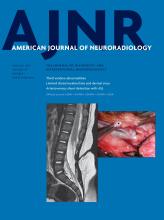Index by author
Hui, E.S.
- Adult BrainYou have accessStructural Brain Network Reorganization in Patients with Neuropsychiatric Systemic Lupus ErythematosusX. Xu, E.S. Hui, M.Y. Mok, J. Jian, C.S. Lau and H.K.F. MakAmerican Journal of Neuroradiology January 2017, 38 (1) 64-70; DOI: https://doi.org/10.3174/ajnr.A4947
Hulst, H.E.
- EDITOR'S CHOICEAdult BrainOpen AccessHippocampal and Deep Gray Matter Nuclei Atrophy Is Relevant for Explaining Cognitive Impairment in MS: A Multicenter StudyD. Damjanovic, P. Valsasina, M.A. Rocca, M.L. Stromillo, A. Gallo, C. Enzinger, H.E. Hulst, A. Rovira, N. Muhlert, N. De Stefano, A. Bisecco, F. Fazekas, M.J. Arévalo, T.A. Yousry and M. FilippiAmerican Journal of Neuroradiology January 2017, 38 (1) 18-24; DOI: https://doi.org/10.3174/ajnr.A4952
Brain dual-echo, 3D T1-weighted, and double inversion recovery scans were acquired at 3T from 62 patients with relapsing-remitting MS and 65 controls. Focal WM and cortical lesions were identified, and volumetric measures from WM, cortical GM, the hippocampus, and deep GM nuclei were obtained. Compared with those with who were cognitively preserved, patients with MS with cognitive impairment had higher T2 and T1 lesion volumes and a trend toward a higher number of cortical lesions. Significant brain, cortical GM, hippocampal, deep GM nuclei, and WM atrophy was found in patients with MS with cognitive impairment versus those who were cognitively preserved. The authors conclude that hippocampal and deep GM nuclei atrophy are key factors associated with cognitive impairment in MS.
Hurley, M.C.
- EDITOR'S CHOICENeurointerventionOpen AccessEmergent Endovascular Management of Long-Segment and Flow-Limiting Carotid Artery Dissections in Acute Ischemic Stroke Intervention with Multiple Tandem StentsS.A. Ansari, A.L. Kühn, A.R. Honarmand, M. Khan, M.C. Hurley, M.B. Potts, B.S. Jahromi, A. Shaibani, M.J. Gounis, A.K. Wakhloo and A.S. PuriAmerican Journal of Neuroradiology January 2017, 38 (1) 97-104; DOI: https://doi.org/10.3174/ajnr.A4965
The authors investigated the role of emergent endovascular stenting of long-segment carotid dissections in the acute ischemic stroke setting in 15 patients. They specifically evaluated long-segment carotid dissections requiring stent reconstruction with multiple tandem stents (≥ 3 stents) and presenting with acute (<12 hours) ischemic stroke symptoms (NIHSS score, ≥ 4). Carotid stent reconstruction was successful in all patients with no residual stenosis or flow limitation. Nine patients (60%) harbored intracranial occlusions, and 6 patients (40%) required intra-arterial thrombolysis/thrombectomy, achieving 100% TICI 2b–3 reperfusion. They conclude that emergent stent reconstruction of long-segment and flow-limiting carotid dissections in acute ischemic stroke intervention is safe and effective, with favorable clinical outcomes.
Huynh, T.J.
- Spine Imaging and Spine Image-Guided InterventionsYou have accessFirst-Pass Contrast-Enhanced MRA for Pretherapeutic Diagnosis of Spinal Epidural Arteriovenous Fistulas with Intradural Venous RefluxS. Mathur, S.P. Symons, T.J. Huynh, P. Muthusami, W. Montanera and A. BharathaAmerican Journal of Neuroradiology January 2017, 38 (1) 195-199; DOI: https://doi.org/10.3174/ajnr.A5008
- Spine Imaging and Spine Image-Guided InterventionsYou have accessFirst-Pass Contrast-Enhanced MR Angiography in Evaluation of Treated Spinal Arteriovenous Fistulas: Is Catheter Angiography Necessary?S. Mathur, S.P. Symons, T.J. Huynh, T.R. Marotta, R.I. Aviv and A. BharathaAmerican Journal of Neuroradiology January 2017, 38 (1) 200-205; DOI: https://doi.org/10.3174/ajnr.A4971
- Spine Imaging and Spine Image-Guided InterventionsYou have accessComparison of Time-Resolved and First-Pass Contrast-Enhanced MR Angiography in Pretherapeutic Evaluation of Spinal Dural Arteriovenous FistulasS. Mathur, A. Bharatha, T.J. Huynh, R.I. Aviv and S.P. SymonsAmerican Journal of Neuroradiology January 2017, 38 (1) 206-212; DOI: https://doi.org/10.3174/ajnr.A4962








